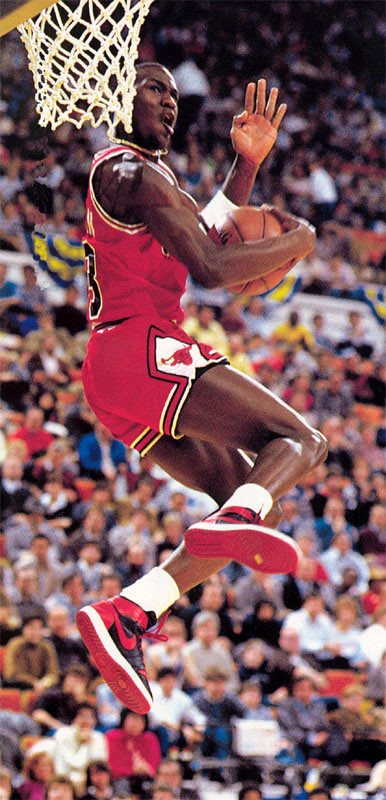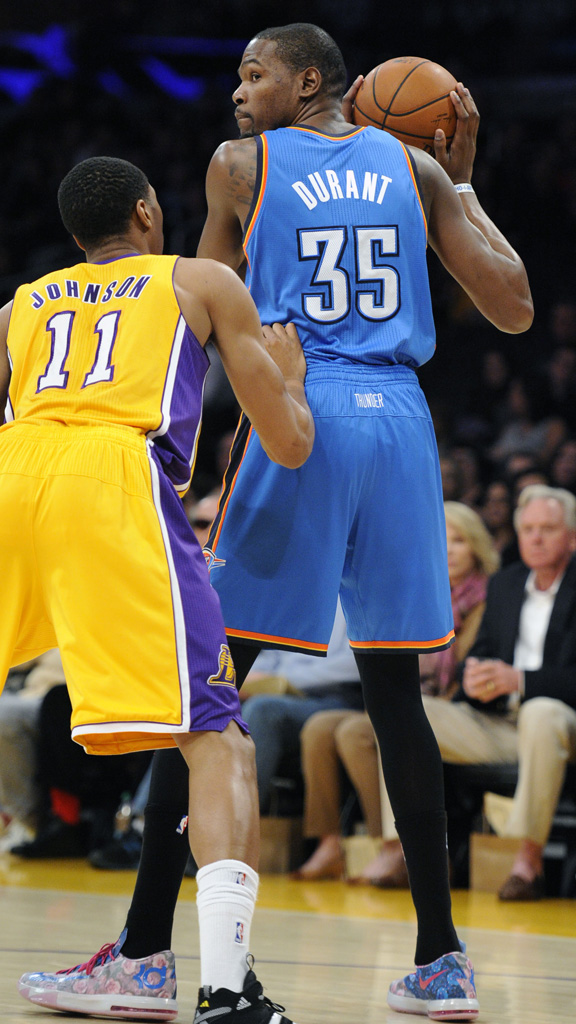1.

by Gerald Flores
Sneaker rules in the NBA have come a long way since Michael Jordan’s black and red Nikes were banned by league commissioner David Stern in 1984.
Policies have changed, and colorways other than the standard black or white are far more accepted in today’s league. Players basically have the option to mix up their sneakers every night, as long as the sneakers are in line with team colors. For example, LeBron James has already worn over 30 different versions of the Nike LeBron 12 this season.
“We had specific requests come through. Sometimes it was from a footwear company or sometimes a player via the team’s equipment manager,” said Christopher Arena, the NBA’s VP of identity, outfitting, and equipment. “This came at time when customizing shoes online through adidas or Nike and other footwear manufacturers became possible. Many of the players have a pretty keen fashion sense, and they wanted to be more specific about their sneakers.”
Other than that, players are also allowed to break code with their sneakers during special occasions. Sure there’s Christmas and the All-Star Game, but did you know that teams are allowed to wear purple, green, and gold sneakers during Mardis Gras or kicks in shades of blue for Autism Awareness? The latest in the NBA's "celebrations" was the Chinese New Year, which my only debuted new uniforms, but allowed teams participating in last week's games to wear sneakers with red and gold.
Throughout the NBA season, there are about 18 of these similar occasions where pros can lace up sneakers outside of their team colors.
But how did these holidays come about in the NBA? Sole Collector caught up with Arena for a full breakdown on NBA sneaker guidelines.
 30 years ago, Michael Jordan was getting fined for wearing black and red Nikes. Is it safe to say NBA has become more lenient as far as sneakers go?
30 years ago, Michael Jordan was getting fined for wearing black and red Nikes. Is it safe to say NBA has become more lenient as far as sneakers go?
It certainly evolved over the years. In 2009, a majority of shoes had to be a specific color and white or black. Then we really opened up those doors up a little bit and really spoke to the team’s colors.
When we talk about uniformity, which is what the spirit of the rule is grounded in. You can think of that in a variety of ways. In regards to every uniform, players get a tank top, they get a short. There’s also uniformity in terms of color. Green for the Celtics so to speak, and numbers are all white and a certain size, and the watermarks are all identifiable. Those are all uniform aspects.
We made the leap or we evolved from the uniformity [of the shoes] being majority white or black to being your team colors on your shoe in any proportion that you wanted. The team is unified by the colors of their team more than anything else.
If a player is going to wear shoes, it’s not going to matter if it’s all white, all black , all green, or a percentage of white, black, and green—we’re all Celtics. And when you wear that with the uniform that all makes sense.
Was there a specific turning point that started that conversation? Was it the players asking for that or the brand partners of the league asking for that?
I don’t recall specifically. My sense is that it was a combination of both. Our footwear partners adidas and Nike, and our outfitting partner adidas, certainly have been involved in all parts of outfitting our teams. I’m sure that was a percentage of it. I wasn’t involved in those conversations specifically, but I’m sure the players did as well.
We’re all about the teams being teams and players representing their brands in the best way. We’re all for that.
Now theres also periods in the season where players can wear color palettes that don’t match the uniform. Where did that originate from?
I believe that was in 2012. We had specific requests come through. Sometimes it was from a footwear company or sometimes a player via the team’s equipment manager. This came at time when customizing shoes online through adidas or Nike and other footwear manufacturers became possible. Many of the players have a pretty keen fashion sense, and they wanted to be more specific about their sneakers.
It also was a time where we started to line ourselves up with certain events as well. So we have Fit Week, Green Week, Veteran's Day, or Hoops for Troops, or other celebrations where we’d issue the teams specific warm-ups, special shooting shirts, headbands. So we started to connect the dots and say, ‘How can we complete this package?’ We should allow the footwear companies some opportunities here with our teams and players to design footwear that aligns with that.
2.

How’d you pick which days to let the players and brands do this?
We really looked at that calendar, between our pre-season and regular season and asked ourselves, ‘What would make sense?’ What makes sense to the consumer who’s into NBA basketball? You see players are wearing red shoes. You’d say, “I get it. It’s Valentine’s Day.”
Some of the holidays may be a little bit deeper. You may need the element of discovery and dig deep to find out, but I think those people that are into sneakers would get it or figure out a way to get it.
There are opportunities that aren’t utilized as much like a Green Week, and Fit Week, Autism Awareness night. It may be because those are better served as a lapel pin on the coach, or Hoops for St. Jude’s or Valentines Day that could fall on All-Star Weekend.
How close does the league work with brands with giving them a heads up on color palettes?
I think we’ve conditioned them over the past couple years on what those color palettes are going to be. The colors don’t really change. It’s not purple for St. Patrick’s Day. Many of the brands are simply intuitive. We just ask them to provide us with what their stories are and what their colors are in advance for each half of the season so that we can review them and sign off and make sure they’re within color palette that we’re asking for.
 In terms of the regular season, how close does the league watch for uniformity in terms of outfitting?
In terms of the regular season, how close does the league watch for uniformity in terms of outfitting?
There’s a system where we monitor all activities in the game. It could be sound in the arena or uniform violation. It could be a player not wearing their uniform the right way or someone not wearing the right color on their sneakers. Whatever it may be, shoes are a part of that.
I will say, I can count on my hand how many times a sneaker violation happens. Footwear companies are in tune to what’s happening. The teams and the group of 30 equipment managers in the league are the best and they listen and understand what our guidelines are and our obligations to our partners. It’s rare.
Also, there’s so much freedom working within your teams color palette. It’s really intuitive. The teams want to look unified and there’s not that many violations out there.
If there is a violation, what are the repercussions of that?
Our basketball operations group will handle that and it’s typically a warning if the player just didn’t know about it. We’ll try to help them get it right.
Where do you see this going forward? Are there new events on the horizon?
I don’t know. Do you agree that we can’t have too many special nights because then it’s not special anymore?
I guess there’s some truth to that.
What if there were less days and more freedom?Let’s say you took out certain non-descript days like Grammys or the Oscars, and you said, for Christmas Day, you can wear whatever you want- just like All-Star. That might provide some variety and innovation from the footwear companies. And our players might have more fun. We have about 18 [holidays] where we have something right now.
We talk about everything. Like should a player be able to wear whatever he wants on his birthday? I think we’ve exhausted every date. I really believe that. But now the questions is, do we expand the colors?
3.


